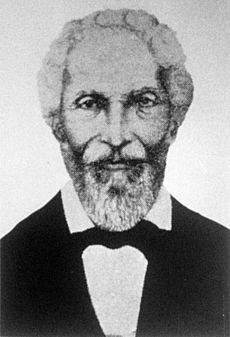Rancho San Ramon (Amador) facts for kids

Rancho San Ramon was a large piece of land in what is now Contra Costa County, California. Its name means "St. Raymond Ranch" in Spanish. This rancho was a Mexican land grant, which means the Mexican government gave this land to someone. Rancho San Ramon covered about 20,968 acres (84.85 km²). It was located in the southern part of the San Ramon Valley. Another rancho, called Rancho San Ramon (Pacheco-Castro), was right next to it in the northern part of the valley.
In 1834, the governor of California, Jose Figueroa, gave this land to a man named Jose Maria Amador. The rancho stretched from what is now southern Danville down to Dublin. It also included the area known today as Dougherty Valley. For many years, the Dublin area was even called "Amador."
Who Was José María Amador?
José María Amador lived from 1794 to 1883. He was born in Presidio of San Francisco, which was a Spanish fort. He was one of eleven children. It's thought that he named his ranch after his mother, Ramona Noriega, and his grandfather, Ramón Noriega. Later, Amador County was named in his honor.
Amador started his life as a soldier and explorer. He served in the army of New Spain, which was what Mexico and parts of the U.S. were called before Mexico became independent. After his time as a soldier, he became an administrator at Mission San José. He built several adobe buildings (made from sun-dried earth bricks) on his rancho near Alamilla Springs, in what is now Dublin. One of these was a two-story adobe house.
Rancho San Ramon Becomes Part of the U.S.
After the Mexican–American War, California became part of the United States in 1848. The Treaty of Guadalupe Hidalgo was signed, which said that the land grants given by Mexico would still be valid.
In 1852, Jose Maria Amador officially claimed his Rancho San Ramon land with the U.S. government. In 1865, he was given the official ownership (called a patent) for about 16,517 acres (66.84 km²) of the rancho. Over time, Amador began to sell off parts of his large rancho. For example, James Witt Dougherty bought 10,000 acres (40.47 km²) in 1852.
The Norris Family's Land
In 1850, a couple named Leo and Mary Jane Norris bought a section of land from Jose Maria Amador. This piece of land was about one square league (a measurement of land) in the northwest corner of the rancho. They also filed a claim for their land with the government in 1852. In 1882, Leo Norris was given the official ownership for about 4,451 acres (18.01 km²).

